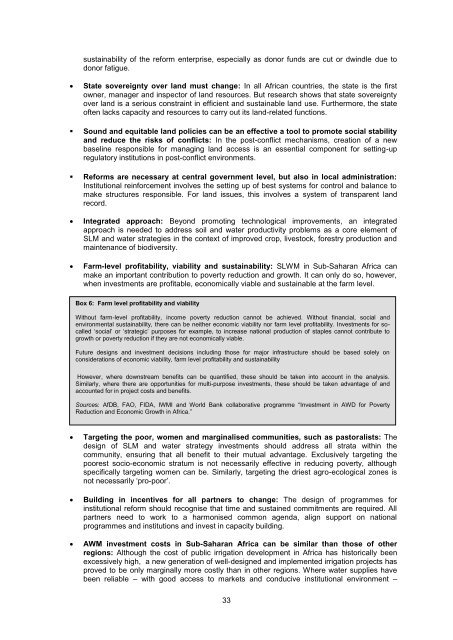The CAADP Pillar I Framework
The CAADP Pillar I Framework
The CAADP Pillar I Framework
- No tags were found...
You also want an ePaper? Increase the reach of your titles
YUMPU automatically turns print PDFs into web optimized ePapers that Google loves.
sustainability of the reform enterprise, especially as donor funds are cut or dwindle due todonor fatigue.State sovereignty over land must change: In all African countries, the state is the firstowner, manager and inspector of land resources. But research shows that state sovereigntyover land is a serious constraint in efficient and sustainable land use. Furthermore, the stateoften lacks capacity and resources to carry out its land-related functions.• Sound and equitable land policies can be an effective a tool to promote social stabilityand reduce the risks of conflicts: In the post-conflict mechanisms, creation of a newbaseline responsible for managing land access is an essential component for setting-upregulatory institutions in post-conflict environments.• Reforms are necessary at central government level, but also in local administration:Institutional reinforcement involves the setting up of best systems for control and balance tomake structures responsible. For land issues, this involves a system of transparent landrecord.Integrated approach: Beyond promoting technological improvements, an integratedapproach is needed to address soil and water productivity problems as a core element ofSLM and water strategies in the context of improved crop, livestock, forestry production andmaintenance of biodiversity.Farm-level profitability, viability and sustainability: SLWM in Sub-Saharan Africa canmake an important contribution to poverty reduction and growth. It can only do so, however,when investments are profitable, economically viable and sustainable at the farm level.Box 6: Farm level profitability and viabilityWithout farm-level profitability, income poverty reduction cannot be achieved. Without financial, social andenvironmental sustainability, there can be neither economic viability nor farm level profitability. Investments for socalled‗social‘ or ‗strategic‘ purposes for example, to increase national production of staples cannot contribute togrowth or poverty reduction if they are not economically viable.Future designs and investment decisions including those for major infrastructure should be based solely onconsiderations of economic viability, farm level profitability and sustainabilityHowever, where downstream benefits can be quantified, these should be taken into account in the analysis.Similarly, where there are opportunities for multi-purpose investments, these should be taken advantage of andaccounted for in project costs and benefits.Sources: AfDB, FAO, FIDA, IWMI and World Bank collaborative programme ―Investment in AWD for PovertyReduction and Economic Growth in Africa.‖Targeting the poor, women and marginalised communities, such as pastoralists: <strong>The</strong>design of SLM and water strategy investments should address all strata within thecommunity, ensuring that all benefit to their mutual advantage. Exclusively targeting thepoorest socio-economic stratum is not necessarily effective in reducing poverty, althoughspecifically targeting women can be. Similarly, targeting the driest agro-ecological zones isnot necessarily ‗pro-poor‘.Building in incentives for all partners to change: <strong>The</strong> design of programmes forinstitutional reform should recognise that time and sustained commitments are required. Allpartners need to work to a harmonised common agenda, align support on nationalprogrammes and institutions and invest in capacity building.AWM investment costs in Sub-Saharan Africa can be similar than those of otherregions: Although the cost of public irrigation development in Africa has historically beenexcessively high, a new generation of well-designed and implemented irrigation projects hasproved to be only marginally more costly than in other regions. Where water supplies havebeen reliable – with good access to markets and conducive institutional environment –33
















